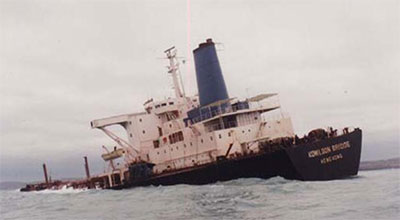The end of 1986 saw Ireland experiencing one of its worst oil pollution disasters when the super tanker Kowloon Bridge ended its transatlantic journey on The Stags, off Toe Head, West Cork. The journey started at Quebec, Canada for the River Clyde, Scotland in November 1986 with almost 2,000 tonnes of fuel oil and a dry cargo of 160,000 tonnes of British Steel owned marble sized iron ore pellets.

The tanker was built at the Swan Hunter Shipyards on the Tees in the UK with a gross tonnage of 89,438. When it was launched as the English Bridge on 25th September 1972, it remained in continuous service until it went aground at The Stags in 1986. As it changed owners, so did its name and was called Sunshine (1979), Mercurio (1980) and Crystal Transporter (1983). It was one of six sister ships, one of which was the ill-fated Derbyshire which the UK Department of Transport initially concluded “was probably overwhelmed by the forces of nature in typhoon Orchid, possibly after getting beam on to wind and sea, off Okinawa in darkness on the night of 9/10 September 1980 with the loss of 44 lives.”
The Kowloon Bridge was a combination carrier also known as an OBO, which could carry ore, bulk dry cargo, or oil. Modifications were made to its odd numbered holds, which allowed it to carry iron ore in them. The even numbered holds remained empty under normal circumstances. It was 294 metres long, maximum width of 44 metres, 25 metres depth and boasts to be the largest wreck in the world by tonnage. Effectively, it was as long as three football fields and larger than RMS Titanic.
The tanker’s journey to Scotland was stalled as heavy weather caused it to take refuge in Bantry Bay, West Cork where surveys found some serious deck cracks at frame 65. This is a transverse watertight bulkhead that separates Hold 9 from the pump room. In March 1982 another sister ship, the Tyne Bridge, encountered severe weather in the North Sea and her deck plating started to crack just forward of the bridge in the same location. The four other remaining sister ships were contacted and it is reported that each one was found to have similar damage of varying degrees at frame 65. Following this revelation, the Derbyshire Family Association still failed in their petition to the UK Government to hold an enquiry into the circumstances of the sinking of the Derbyshire just two year earlier. It was only after the Kowloon Bridge incident that the Derbyshire investigation took place between October 1987 and March 1988 with inconclusive findings. Notably, in 1994 the wreck was located in over 4,000 metres and the subsequent UK enquiry in 2000 found that the sinking was unlikely to be the fault of frame 65. It concluded that some air pipes on the foredeck were damaged in the heavy seas and the sea started crashing into the forward hatch as the bow dropped lower in the water. The hatch soon gave way and the fate of the Derbyshire was sealed.
While anchored at Bantry Bay on Saturday morning, 22nd November 1986, the starboard anchor chain of the Kowloon Bridge snapped in a sudden change of wind in the continuing storm and it was decided to ride out the weather in open seas. The fact that the Capo Emma, a disabled oil tanker carrying 80,000 tonnes of crude oil, was at anchor less than a mile from the Kowloon Bridge probably helped Captain Rao in his decision to move.
Rough seas caused slow progress out of the bay and within 12 hours, some reports had the tanker struggling in 15-metre swells and 70mph winds. At 11.02pm on Saturday night the captain radioed that the steering gear had failed and requested immediate assistance. One crew member was later quoted as saying that “all hell broke loose around 11pm when most of the crew were asleep.” By 1am on Sunday 23rd November, it was abandoned with all 28 crew and two shipping company representatives being airlifted in terrible conditions 15 miles east of Mizen Head. The two RAF Sea King rescue crews attending the scene requested the engines to be left running to assist the rescue operations. It was then left to drift at the mercy of the seas, fully lit with an engine speed of about one knot.
It drifted some distance south of the Fastnet Rock and at 3.15pm was spotted by the Irish Naval vessel L.E. Aoife while on route to assist a Spanish trawler in distress. After changing direction northwards towards the West Cork coastline in the SW gale, the tanker’s progress could be observed more easily. It passed Cape Clear and at about 11pm on the 23rd, according to local reports, it came within 60 metres south of Kedge Island, although the Baltimore Lifeboat crew reported that it passed at about 150 metres distance. Although it appeared that it might drift ashore near Baltimore, the tanker continued eastwards to rest at The Stags where it went aground at approximately 2.54am on the 24th. It had been drifting for over 24 hours before grounding. By late afternoon the vessel had apparently broken between hatches 2 and 3 and a reported oil slick 1½ mile long was being blown eastwards in a Force 8 gale. Attempts by salvage companies, Smit and Wijsmuller, failed to re-float it and on 3rd December after further battering by the elements, it finally slipped into deeper water to sit on the bottom in an upright position, causing the oil release to continue for days after. It lies about 400 metres SW of The Stags with her bows facing to the NNW.
View of The Stags
The bad weather continued and on 9th December, a diver was sent down to investigate and it was reported that in the poor conditions he was nearly trapped in the wreckage. Perhaps it was salvage diver Rob Koper, who reported that he nearly lost his life trying to shut valves that were spilling oil. The iron ore cargo has since made the footnotes in many newspapers as it was seen as a salvageable commodity. In 1997 a newspaper reported that a “scrap dealer”, Shaun Kent, paid £1 for the wreck and that he hoped to complete the salvage of the estimated £7 million in iron ore by the following summer. To date, no successful salvage operation has taken place. The vessel was insured for £8.4 million and the cargo for £2.7 million.
The wreck was effectively off limits with a 1,000-metre exclusion zone. However, at some stage a ‘blind-eye’ was apparently turned to sports divers and I am not sure when or by whom the first non-salvage dives were done but a local dive operator was taking sports divers to the wreck in 1991. Soon after the sinking, the aluminium-constructed wheelhouse was in a heap on the bottom beside the stern in about 45 metres. The mid section had obvious serious damage and the bow sat in about 36 metres. The port side of the wreck was open to the full force of the Atlantic seas as storms hit the port side of this huge wall of steel in their path. Until recently, orientation was relatively easy on the bow, but diving at the stern area requires some idea of the ships layout due to the jumble of hull and deck plating and pipe work.
In July 1992 Kish SAC visited the West Cork area and my first dive on the wreck was on the 14th. It is only when you dive the wreck do you get any sense of how big it actually is. We started the dive near the foredeck in about 8 metres and soon dropped over the side to head to the sea floor, or so we thought. Because of the massive scale of the wreck we were actually dropping down along into the forward hold. It bottomed out at a bed of iron ore at about 22 metres. Apparently, the holds were only partially filled because of the weight of the iron ore.
Rising out of the hold we entered the cavernous bow at a break near the starboard side. Using torches we had a good look around inside the bare interior and at one point I instinctly put my hand up to hold position off the upper bulkhead before exiting to see more of the wreck. After some minutes I saw a lump of oil on my gloved hand, the one I had used to help me equalise and adjust buoyancy. Quite simply, I had put my hand in crude oil floating under a ceiling in the bow and managed to spread it to anything I touched before I spotted the problem. Later at the surface, I remember letting others take off my weight belt, cylinder and ABLJ before lifting me backwards into the RIB to avoid contaminating anything else.
I have had ten dives on the site, all coincidentally in July or September and predominantly at the forward part of the wreck, although after dive one I learned to keep my hands to myself when inside the bow. The residual oil has long since dispersed. A typical dive meant landing on the foredeck and dropping into the bow compartments to explore it using the large hatches between decks. Looking at the inside of the hull, the occasional cracks in the plating were plain to see and I often wondered how long this part of the wreck would stay intact. Leaving the bow, I would drop into the first hold before going over the side to the seabed to where iron ore had burst out of the wreck and had been sculpted into large ripples by the currents. The bulbous bow was always worth a good look before going up to the massive stockless port anchor held tightly in position with its shank pulled up into the hawse pipe (remember the starboard anchor was left in Bantry Bay). A diver could sit beside one fluke while their buddy could sit at the other and watch the fish swim past.
Up until 2001, it was possible to swim up (or down) through the empty starboard hawse pipe even with a twin set, but on my next visit in 2004 some of the remaining chain links had been dislodged to hang into the pipe preventing a safe swim through. The dive would be finished off decompressing on the foredeck. The exposed exterior walls of the wreck created a massive reef for organisms to populate and the bio-diversity was immense, and included wrasse and pollock, varied anemones, together with soft and hard corals. This dive profile was possible up to late summer 2006. The bow section deteriorated over the winter of 2007 and reports stated that it had completely collapsed. Our next visit in 2008 confirmed that the Kowloon Bridge wreck was now indeed a ‘wreck’. We landed closer to the second hold back from the now collapsed bow and found a series of broken and bucked plates of steel with lots of iron ore as the foundation of this piece of modern art. Trying to orientate is now made more difficult and compasses have never had any use at the site (I wonder why…?) although I look forward to having a good explore around the bow area to see what is left. Perhaps the anchor is still visible, or has it pulled the hull on top of itself to be hidden from view until a storm reveals it again?
